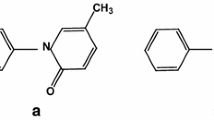Summary
Multiple-dose pharmacokinetics of pefloxacin were evaluated in 25 patients with hepatocellular insufficiency. The severity of liver disease was graded A, B or C according to the Child-Pugh classification. Pharmacokinetic parameters evaluated in patients on day 1 of treatment were compared with those computed in 11 healthy volunteers (the control group) after a single dose. Blood samples were taken at frequent intervals after drug administration and assayed by high performance liquid chromatography. The mean age of patients with liver impairment was slightly greater (59.5 years, range 33 to 81 years) than that of the control group (46.7 years, range 42 to 51 years).
In the patients with liver disease, the mean (± SD) half-life of elimination, although highly variable, was significantly longer (46.3 ± 42.5 hours) than in the control group (11.3 ± 3.5 hours, p < 0.001). The total clearance was significantly decreased (1.76 ± 1.31 L/h vs 6.03 ± 2.99 L/h in the control group). In groups B and C of the Child-Pugh classification, total body clearance was about 30% of normal values. Elimination half-life increased by 200% in group B and 373% in group C compared with values in healthy volunteers. Intergroup differences (group B vs group C of the Child-Pugh classification) were not statistically significant.
The minimum concentrations inhibiting 90% of Gram-negative strains (MIC90) were exceeded by plasma pefloxacin concentrations throughout treatment. For most patients, trough plasma concentrations were above 2 mg/L and peak plasma concentrations averaged 8.5 mg/L. Large inter- and intraindividual variations in the elimination half-life, total clearance and volume of distribution were observed. A practical index is proposed for estimating the most likely pharmacokinetic parameters for a given patient, taking into account the values of the Child-Pugh score or the prothrombin time.
Similar content being viewed by others
References
Albers I, Hartmann H, Bircher J, Creutzfeldt W. Superiority of the Child-Pugh classification to quantitative liver function tests for assessing prognosis of liver cirrhosis. Scandinavian Journal of Gastroenterology 24 (3): 269–276, 1989
Barré J, Houin G, Tillement JP. Dose-dependent pharmacokinetic study of pefloxacin, a new antibacterial agent, in humans. Journal of Pharmaceutical Sciences 73: 1379–1382, 1984
Black M, Arias IM. Pharmacological considerations in liver disease. In Schiff (Ed.) Disease of the liver, 4th ed., pp. 755–773, Lippincott, Philadelphia, 1975
Bouvet O, Bressolle F, Courtieu C, Galtier M. Penetration of pefloxacin into gynaecological tissues. Journal of Antimicrobial Chemotherapy 29: 579–587, 1992
Danan G, Montay G, Cunci R, Erliger S. Pefloxacin kinetics in cirrhosis. Clinical Pharmacology and Therapeutics 38: 439–442, 1985
Duval J, Acar JF, Bergogne-Bérézin E, Christol D, Courtieu AL, et al. In vitro activity of pefloxacin against 3,422 strains: a multicenter study. In Spitzy & Karrer (Eds) Pefloxacin, Thirteenth International Congress of Chemotherapy, Vienna, August 28–September 3, 1983. Part 110, pp. 7–9, 1983
Fabre D, Bressolle F, Gomeni R, Bouvet O, Dubois A, et al. Identification of patients with impaired hepatic drug metabolism by using a limited sampling procedure for estimation of phenazone (antipyrine) pharmacokinetic parameters. Clinical Pharmacokinetics 24: 333–343, 1993
Fourtillan JB. Comportement pharmacocinétique de la péfloxacine chez l’homme. Revue de Médecine Interne 7: 185–195, 1986
Frydman AM, Le Roux Y, Lefebvre MA, Djebbar F, Fourtillan JB, et al. Pharmacokinetics of pefloxacin after repeated intravenous and oral administration (400mg bid) in young healthy volunteers. Journal of Antimicrobial Chemotherapy 17 (Suppl. B): 67–79, 1986
Granneman GR, Mahr G, Locke C, Nickel P, Kirch W, et al. Pharmacokinetics of temafloxacin in patients with liver impairment. Clinical Pharmacokinetics 22 (Suppl. 1): 24–32, 1992
Gomeni C, Gomeni R. SIPHAR: an integrated computer system for statistical and pharmacokinetic data analysis. In Serio et al. (Eds) Proceedings of the 7th International Congress of Medical Informatics, Europe 87, Rome, 1987, pp. 507–516, European Federation for Medical Informatics, Rome, 1987
Kleinbloesem CH, Van Harten J, Wilson JPH, Danhof M, Van Brummelen P, et al. Nifedipine: kinetics and hemodynamic effects in patients with liver cirrhosis after intravenous and oral administration. Clinical Pharmacology and Therapeutics 40: 21–28, 1986
Montay G, Goueffon Y, Roquet F. Absorption, distribution, metabolic fate and elimination of pefloxacin mesylate in mice, rats, dogs, monkeys and humans. Antimicrobial Agents and Chemotherapy 25: 463–472, 1984
Ohnishi A, Tsuboi Y, Ishizaki T, Kubota K, Ohno T, et al. Kinetics and dynamics of enalapril in patients with liver cirrhosis. Clinical Pharmacology and Therapeutics 45: 657–665, 1989
Orrego H, Israel Y, Blake JE, Medline A. Assessment of prognostic factors in alcoholic liver disease: toward a global quantitative expression of severity. Hepatology 3: 896–905, 1983
Piotrowskii VK. Pharmacometrics: the use of Weibull distribution to describe the in vivo absorption kinetics. Journal of Pharmacokinetics and Biopharmaceutics 15: 681–686, 1987
Sörgel F, Jaehde U, Naber K, Stephan U. Pharmacokinetic disposition of quinolones in human body fluids and tissues. Clinical Pharmacokinetics 16 (Suppl. 1): 5–24, 1989
Taburet AM, Steimer JL, Doucet D, Singlas E. Le temps de présence moyen dans l’organisme: un nouveau paramêtre pharmacocinétique. Thérapie 41: 1–10, 1986
Verbist L. In-vitro activity of pefloxacin against micro-organisms multiply resistant to β-lactam antibiotics and aminoglycosides. Journal of Antimicrobial Chemotherapy 17 (Suppl. B): 11–17, 1986
Williams RL. Drug administration in hepatic disease. New England Journal of Medicine 309: 1616–1622, 1983
Author information
Authors and Affiliations
Rights and permissions
About this article
Cite this article
Galtier, M., Bressolle, F., de la Coussaye, JE. et al. Multiple-Dose Pharmacokinetics of Pefloxacin in Patients with Hepatocellular Deficiency. Clin. Pharmacokinet. 25, 415–423 (1993). https://doi.org/10.2165/00003088-199325050-00007
Published:
Issue Date:
DOI: https://doi.org/10.2165/00003088-199325050-00007




